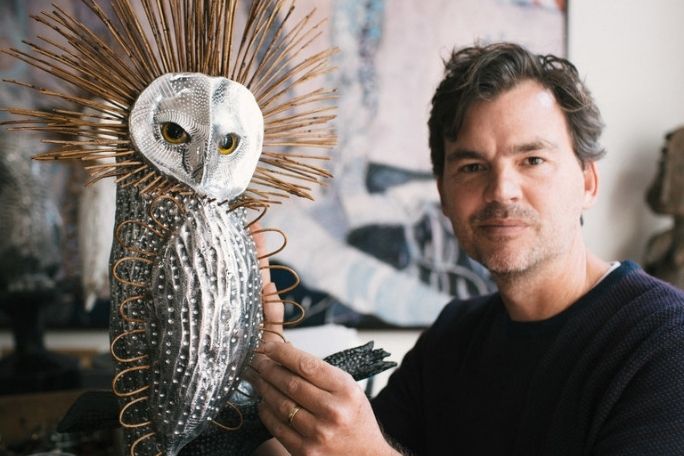Lesson summary
Have you ever thought of art as a friend, something that could keep you grounded, and safe or help you reconnect with who you are and nature?
Joshua Yeldham has been drawing, painting and sculpting owls for many years. Throughout the unit of lessons, Joshua talks deeply about his connection with owls and his emotion-evoking journey through adulthood.
The artist’s sculptures and paintings of owls became a metaphor for hope and a way for him to unpack his thoughts. Joshua discusses this insight and journey through art-making while he teaches students how to sculpt and mould their very own owl and friend.
Tip: Ensure you remind students that patience and cooperation are needed here as this lesson will span over a couple of days as the plaster will need time to dry and set. However, the reveal will be well worth the wait and your class will have the opportunity to paint and adorn their owl with fresh eyes.
Learning intentions:
Students will...
- investigate how natural materials can be used to create sculptures
- understand how meaning is applied to art
- create an owl sculpture.
Success criteria:
Students can...
- explain how Joshua uses nature to create sculptures
- create a sculpture with natural materials to reconnect with nature
- articulate why and how artists apply meaning to their artwork.
Lesson guides and printables
Lesson details
Curriculum mapping
Australian Curriculum content descriptions:
Years 5 & 6 Visual Arts:
- Develop and apply techniques and processes when making their artworks (ACAVAM115)
- Plan the display of artworks to enhance their meaning for an audience (ACAVAM116)
Year 7 & 8 Visual Art:
- Develop ways to enhance their intentions as artists through exploration of how artists use materials, techniques, technologies and processes (ACAVAM119)
- Practise techniques and processes to enhance the representation of ideas in their art-making (ACAVAM121)
- Analyse how artists use visual conventions in artworks (ACAVAR123)
- Identify and connect specific features and purposes of visual artworks from contemporary and past times to explore viewpoints and enrich their art-making, starting with Australian artworks including those of Aboriginal and Torres Strait Islander Peoples (ACAVAR124)
Syllabus outcomes Stage 3: VAS3.1, VAS3.2, VAS3.3, VAS3.4
Syllabus outcomes Stage 4: 4: 4.1, 4.2, 4.4, 4.5, 4.6
General capabilities: Literacy, Personal and Social Capabilities, Critical and Creative Thinking
Cross-curriculum priority: Sustainability
Relevant parts of Year 5 & 6 achievement standards:
By the end of Year 6, students explain how ideas are represented in artworks they make and view. They describe the influences of artworks and practices from different cultures, times and places on their art-making.
Students use visual conventions and visual arts practices to express a personal view in their artworks. They demonstrate different techniques and processes in planning and making artworks. They describe how the display of artworks enhances meaning for an audience.
Relevant parts of Year 7 & 8 achievement standards:
By the end of Year 8, students identify and analyse how other artists use visual conventions and viewpoints to communicate ideas and apply this knowledge in their art-making. They explain how an artwork is displayed to enhance its meaning. They evaluate how they and others are influenced by artworks from different cultures, times and places.
Students plan their art-making in response to the exploration of techniques and processes used in their own and others’ artworks. They demonstrate use of visual conventions, techniques and processes to communicate meaning in their artworks.
This lesson is part of the wider unit of work: Lord Howe Island – Artist in Residence
Time required: 110 mins
Level of teacher scaffolding: Medium- Facilitate class discussion and set up working stations to sculpt owls
Resources required
- A device capable of presenting a video to the class
- Joshua Yeldham Video – (link provided in the lesson)
- Sculpting materials (clay, bucket, plaster mixture, water, carving tools, brush)
- Painting materials (paint and brush)
- Portfolio or booklet dedicated to the Joshua Yeldham art lessons
- Student resource booklet: Joshua Yeldham Student Resource
- Student Worksheet: How to make an owl sculpture (one per student)
Skills
This lesson is designed to build students’ competencies in the following skills:
- Communication
- Creativity
- Critical thinking
- Cultural understanding
- Social skills
- Problem solving
Additional info
If you would like to access additional information about Joshua Yeldham and the photographs of his wonderful exhibition 'Providence'. Please visit the Arthouse Gallery website: Joshua Yeldham - Providence (arthousegallery.com.au/exhibitions/joshua_yeldham/providence) and the artist's website: Joshua Yeldham (www.joshuayeldham.com.au) for exhibitions and his wonderful book: Surrender (joshuayeldham.com.au/the-books). Providence and Surrender were completed during and after his Artist Residency on Lord Howe Island and during his stay at the Capella Lodge (capellalodge.com.au) on Lord Howe Island.


Welcome back!
Don't have an account yet?
Log in with:
By signing up to Cool.org you consent and agree to Cool's privacy policy to
store, manage and process your personal information. To read more, please see
our privacy policy here(Opens in new tab).
Create your free Cool.org account.
Many of our resources are free, with an option to upgrade to Cool+ for premium content.
Already have an account?
Sign up with:
By signing up to Cool.org you consent and agree to Cool's privacy policy to
store, manage and process your personal information. To read more, please see
our privacy policy here(Opens in new tab).